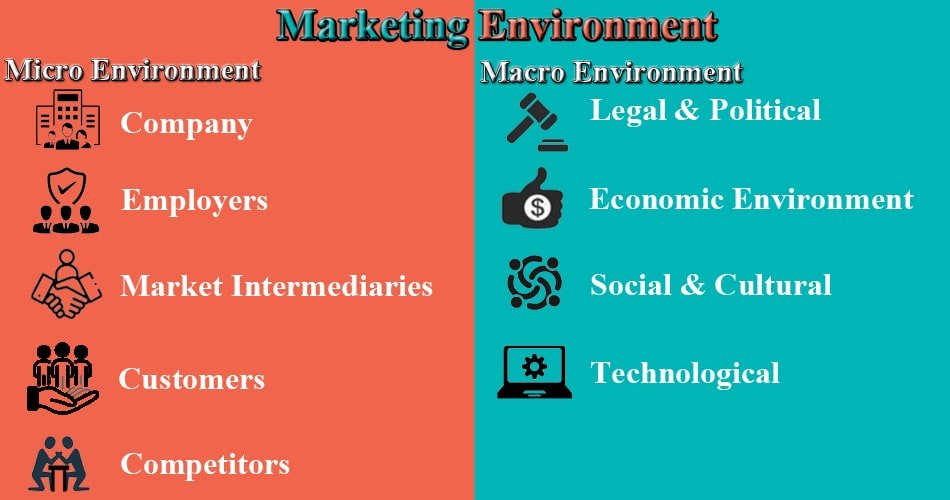Marketing Environment

The marketing environment is the invisible hand that shapes consumer behavior and business strategies.
The marketing environment is the stage where businesses perform their strategies. It encompasses economic trends, social changes, technological advancements, and competitive dynamics. By understanding this environment, marketers can anticipate consumer needs and adapt their strategies, much like a chef adjusting a recipe based on the freshest ingredients available. Businesses must be flexible and responsive to the ever-changing environment around them.
Micro Marketing Environmental Factors
Company
Marketing success begins with strong relationships within the company. Marketing management collaborates with top management, finance, R&D, purchasing, operations, and accounting. These departments form the internal environment, where top management sets the mission, goals, strategies, and policies that guide marketing decisions.
Employees
Employees are the backbone of any business. Training and motivation are essential to enhance their skills, particularly in marketing. Effective training and development programs ensure employees are equipped to meet marketing challenges.
Market Intermediaries
Market intermediaries, such as wholesalers, retailers, and distributors, help businesses distribute their products. They are vital in representing the company’s products in the marketplace.
Customers
Customer satisfaction is the main objective of any organization. Businesses conduct research and develop products to meet customer needs, ensuring satisfaction and loyalty.
Competitors
To succeed, a company must offer more value and satisfaction than its competitors. Marketers must adapt to customer needs and position their products effectively. Strategies vary by industry and company size; large firms may use different tactics than small businesses, but both can achieve high returns with the right approach.
Public
Public opinion can make or break a company’s image. The internet has amplified the public’s voice, making it crucial for businesses to manage their reputation carefully. Positive public perception influences buying decisions and overall success.
Macro Marketing Environmental Factors
Companies operate within a larger macro environment that shapes opportunities and threats. Adaptability to these changes is key to success.
Legal and Political Environment
Government policies and political changes impact marketing conditions. For example, government spending on infrastructure can boost demand in related industries. Marketers must stay informed about legal and political shifts to navigate these challenges effectively.
Economic Environment
The economy processes material and energy inputs into finished goods and services. Marketers need to analyze economic data, such as income distribution, cost of living, and interest rates, to guide their strategies. Economic variables influence consumer behavior, and companies that monitor these trends can capitalize on opportunities.
Social and Cultural Environment
Social changes, such as the demand for organic products and sustainability, impact consumer behavior. Marketers must understand cultural norms and values, which vary by region and evolve slowly. Social trends influence demand for products and services, requiring businesses to adapt to these shifts.
Technological Environment
Technological advancements drive economic progress and competitive advantage. From digital innovations to breakthroughs in biotechnology, technology transforms the marketing environment. Companies that embrace technological changes can stay ahead of the competition and meet evolving consumer needs.
Conclusion
Understanding the marketing environment is crucial for businesses to thrive. By staying informed about micro and macro factors, companies can adapt their strategies to meet consumer needs, outshine competitors, and navigate economic, social, and technological changes. This dynamic approach ensures businesses remain relevant and successful in an ever-evolving marketplace.